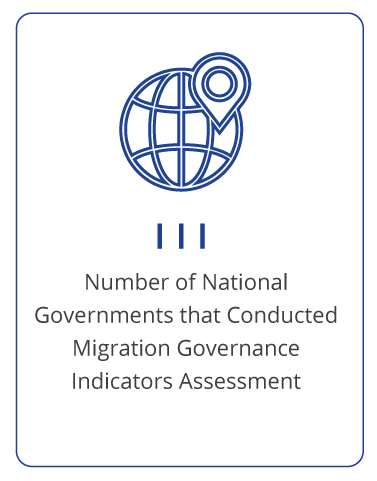-
Who we are
WHO WE AREThe International Organization for Migration (IOM) is part of the United Nations System as the leading inter-governmental organization promoting since 1951 humane and orderly migration for the benefit of all, with 175 member states and a presence in 171 countries.
-
Our Work
Our WorkAs the leading inter-governmental organization promoting since 1951 humane and orderly migration, IOM plays a key role to support the achievement of the 2030 Agenda through different areas of intervention that connect both humanitarian assistance and sustainable development.
What We Do
What We Do
Partnerships
Partnerships
Highlights
Highlights
- Where we work
-
Take Action
Take Action
Work with us
Work with us
Get involved
Get involved
- Data and Research
- 2030 Agenda
Providing advice and support to evidence-based migration policy processes, either for the development of overarching migration policies, or thematic ones targeting a specific element of migration or migration-relevant issue (for example, regular pathways or climate change), is a key part of the mandate of the International Organization for Migration (IOM) and instrumental to the Organization’s mission of promoting humane and orderly migration for the benefit of migrants and societies.
As the international community strives towards the realization of the 2030 Agenda for Sustainable Development and implementation of the Global Compact for Safe, Orderly and Regular Migration (GCM), there is a growing recognition of the need for strengthened policy capacities in the field of migration and mobility as key to advancing towards good migration governance. IOM in its own right, as the leading UN Migration Agency, and as the coordinator and secretariat of the United Nations Network on Migration, advises governments, at their request, on migration policy and enhancing their migration governance systems to reach these shared goals.
IOM has vast experience in promoting policy coherence, enhancing capacity development and providing overall support to the development of comprehensive and evidence-based migration policies that are in line with international human rights standard. IOM engages on policy at all levels, from the global to the local. This concerns overarching migration policies, policies addressing a specific aspect of migration or migrant group, such as labour migration or internally displaced persons (IDPs), as well as mainstreaming of migration into other policy sectors. This includes support with respect to legislation, as well as regulatory and institutional frameworks and systems. IOM has an array of tools, many of them developed jointly with partners, to deliver such support.
IOM’s flagship policy support tool is the Migration Governance Indicators (MGI). MGI helps governments to take stock of their migration policies and strategies to identify good practices and areas with potential for further development. The MGI informs policy change and contributes to the development of migration policies that support good governance of migration by focusing on government ownership of the process. As such, the MGI is a key IOM tool for assisting governments to implement the GCM and the Sustainable Development Goals, as well as for tracking the implementation progress.
IOM’s Essentials of Migration Policymaking capacity development initiative: Experience of the Palauan government officials
In the video below, senior government officials from Palau share their experience of IOM’s support in the development of a national migration policy. In May 2024, IOM organized a policy capacity development workshop for the government and partners in Palau – the Essentials of Migration Policymaking. This kickstarted the governmental process to develop a comprehensive and coherent migration policy in Palau, which is supported by IOM Development Fund.
Migration Governance Insights on Regular Pathways: Delivering on the promise of migration
Regular pathways are essential to realizing the promise of migration. This publication, based on the Migration Governance Indicators (MGI) data from 100 national and 69 local-level assessments conducted between 2016 and 2023, provides insights into what pathways for regular migration look like around the world.
















